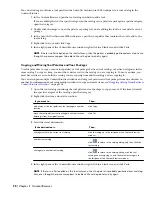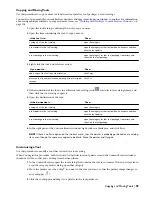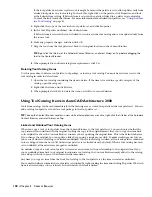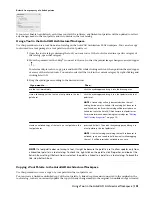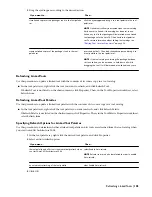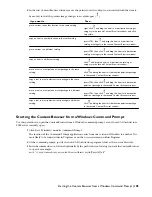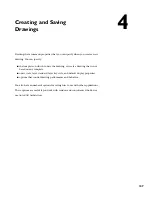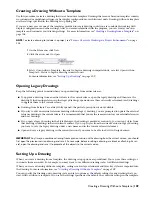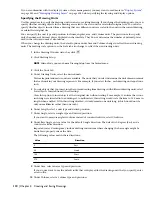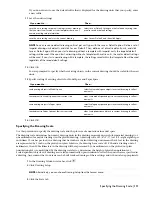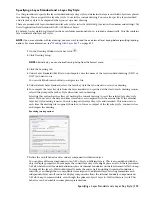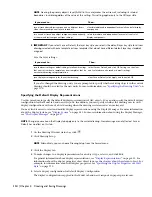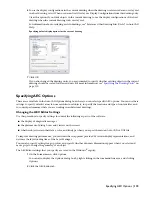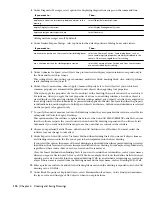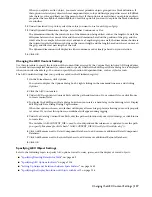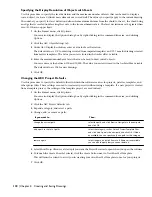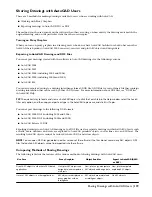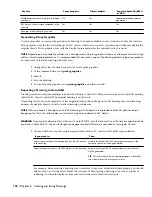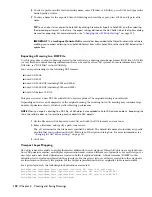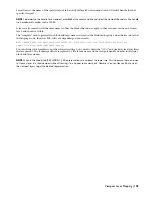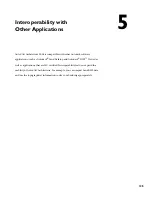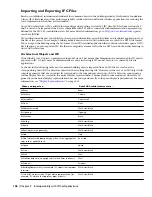
4
Under Scale, select the drawing scale that you want to use.
NOTE The scale values in the Drawing Scale list reflect the current drawing units. To change the drawing units,
see
“
Specifying the Drawing Units
” on page 110
.
If the scale you want to use does not exist in the list, you can click Other, and enter a scale value under
Custom Scales.
5
To edit an existing scale or add a new scale, click Edit Scale List.
■
To edit an existing scale, select it, and click Edit.
■
To add a new scale, click Add, and enter a display name and scale values.
■
To rearrange the order of the scale entries, use the Move up and Move down buttons.
6
Click OK.
7
Select Automatically Create Dim Scale Override, if you want to make the dimension scale match your
drawing scale.
The override applies a scale factor to the dimension style properties.
NOTE AEC dimensions added with tools are not affected by the dimension scale override because an AEC
dimension style depends on which display representation is active. For more, see
“
AEC Dimensions
” on page
1844
.
If you clear Automatically Create Dim Scale Override, the software is prevented from automatically applying
an override to the current dimension scale style in the drawing.
8
Enter a value for Annotation Plot Size.
The annotation plot size is always measured in millimeters for metric drawings and in inches for imperial
drawings. Annotation plot size, multiplied by the drawing scale factor, determines the height of plotted
annotation text.
9
Save the scale settings:
Then…
If you want to…
select Save as Default. Settings on the Units and Layering tabs
are also saved as default settings.
save the scale settings as default settings for new drawings
that you start from scratch or from templates that do not
contain drawing setup information
clear Save as Default, and then click Apply.
save the scale settings only for the current drawing
NOTE You can save one default drawing scale set per unit type with the Save as Default option. Define a set of
imperial drawing scale defaults, and click Save as Default. Next, define a set of metric scale defaults, and click
Save as Default again. When you start a drawing without a template with imperial units, the imperial default
scale will be used. When you start a drawing without a template with metric units, the metric default scale will
be used. When you start a drawing without a template with metric units, the metric default settings will be used.
If you start a new drawing with a template, the settings saved within that template file will be used regardless
of the saved default settings.
10
Click OK.
If you also changed the drawing units, you are prompted to specify whether existing objects in the current
drawing should be scaled for the new units. For more information, see “
Specifying the Drawing Units
” on
page 110.
112 | Chapter 4 Creating and Saving Drawings
Summary of Contents for 00128-051462-9310 - AUTOCAD 2008 COMM UPG FRM 2005 DVD
Page 1: ...AutoCAD Architecture 2008 User s Guide 2007 ...
Page 4: ...1 2 3 4 5 6 7 8 9 10 ...
Page 40: ...xl Contents ...
Page 41: ...Workflow and User Interface 1 1 ...
Page 42: ...2 Chapter 1 Workflow and User Interface ...
Page 146: ...106 Chapter 3 Content Browser ...
Page 164: ...124 Chapter 4 Creating and Saving Drawings ...
Page 370: ...330 Chapter 6 Drawing Management ...
Page 440: ...400 Chapter 8 Drawing Compare ...
Page 528: ...488 Chapter 10 Display System ...
Page 540: ...500 Chapter 11 Style Manager ...
Page 612: ...572 Chapter 13 Content Creation Guidelines ...
Page 613: ...Conceptual Design 2 573 ...
Page 614: ...574 Chapter 14 Conceptual Design ...
Page 678: ...638 Chapter 16 ObjectViewer ...
Page 683: ...Designing with Architectural Objects 3 643 ...
Page 684: ...644 Chapter 18 Designing with Architectural Objects ...
Page 788: ...748 Chapter 18 Walls ...
Page 942: ...902 Chapter 19 Curtain Walls ...
Page 1042: ...1002 Chapter 21 AEC Polygons ...
Page 1052: ...Changing a door width 1012 Chapter 22 Doors ...
Page 1106: ...Changing a window width 1066 Chapter 23 Windows ...
Page 1172: ...1132 Chapter 24 Openings ...
Page 1226: ...Using grips to change the flight width of a spiral stair run 1186 Chapter 25 Stairs ...
Page 1368: ...Using the Angle grip to edit slab slope 1328 Chapter 28 Slabs and Roof Slabs ...
Page 1491: ...Design Utilities 4 1451 ...
Page 1492: ...1452 Chapter 30 Design Utilities ...
Page 1536: ...1496 Chapter 31 Layout Curves and Grids ...
Page 1564: ...1524 Chapter 32 Grids ...
Page 1611: ...Documentation 5 1571 ...
Page 1612: ...1572 Chapter 36 Documentation ...
Page 1706: ...Stretching a surface opening Moving a surface opening 1666 Chapter 36 Spaces ...
Page 1710: ...Offsetting the edge of a window opening on a freeform space surface 1670 Chapter 36 Spaces ...
Page 1956: ...1916 Chapter 42 Fields ...
Page 2035: ...Properties of a detail callout The Properties of a Callout Tool 1995 ...
Page 2060: ...2020 Chapter 45 Callouts ...
Page 2170: ...2130 Chapter 47 AEC Content and DesignCenter ...
Page 2171: ...Other Utilities 6 2131 ...
Page 2172: ...2132 Chapter 48 Other Utilities ...
Page 2182: ...2142 Chapter 51 Reference AEC Objects ...
Page 2212: ...2172 Chapter 52 Customizing and Adding New Content for Detail Components ...
Page 2217: ...AutoCAD Architecture 2008 Menus 54 2177 ...
Page 2226: ...2186 Chapter 54 AutoCAD Architecture 2008 Menus ...
Page 2268: ...2228 Index ...

